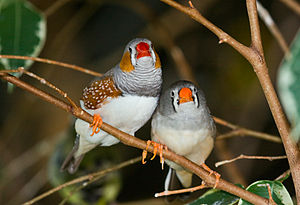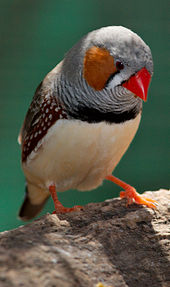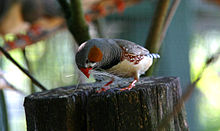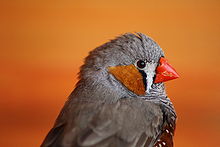- Zebra Finch
-
Zebra Finch 
A pair at Bird Kingdom, Niagara Falls, Ontario, Canada Conservation status Scientific classification Kingdom: Animalia Phylum: Chordata Class: Aves Order: Passeriformes Family: Estrildidae Genus: Taeniopygia Species: T. guttata Binomial name Taeniopygia guttata
Vieillot, 1817The Zebra Finch, Taeniopygia guttata, is the most common and familiar estrildid finch of Central Australia and ranges over most of the continent, avoiding only the cool moist south and the tropical far north. It also can be found natively in Indonesia and East Timor. The bird has been introduced to Puerto Rico, Portugal, Brazil and the United States
The ground-dwelling Zebra Finch grows to a size of about 10 centimetres (3.9 in) long and usually eats grass seeds and Spray Millet. [2] This species' vocalizations consist mostly of chattering trills and calls.
Contents
Habitat
Zebra Finches inhabit a wide range of grasslands and forests, usually close to water.[2] They are typically found in open steppes with scattered bushes and trees, but have adapted to human disturbances, taking advantage of human-made watering holes and large patches of deforested land. Zebra Finches — including many human-bred variants to the species — are widely kept by genetic researchers, breeding hobbyists and pet owners.
The Zebra Finch breeds after substantial rains in its native habitat, which can occur at any time of the year. Birds in captivity are ready to breed year-round. Wild birds are adaptable and varied in their nesting habits, with nests being found in cavities, scrub, low trees, bushes, on the ground, in termite hills, rabbit burrows, nests of other birds, and in the cracks, crevices, and ledges of human structures. Outside of the breeding time, brood nests are constructed for sleeping in.
Lifecycle
The life expectancy of a Zebra Finch is highly variable because of genetic and environmental factors. The Zebra Finch may reach up to 5 years in its natural environment. If they are kept caged they normally live for 8–10 years, if they are well looked after and happy, they will most likely live for around 12 years[3] with the exceptional case of 14.5 years reported for a caged specimen.[4] The greatest threat to the survival of the species are predation by cats and loss of natural food.[2]
Subspecies
There are two sub-species:
- Taeniopygia guttata guttata, the Timor Zebra Finch, extends from Lombok in the Lesser Sunda Islands or Nusa Tenggara in Indonesia to Sermata in addition to coastal areas around the continent of Australia.
- Taeniopygia guttata castanotis is found over the wide range of continental Australia.
The Australian race is sometimes split as Chestnut-eared Finch (Gould, 1837), Taeniopygia castanotis.
The morphological differences between the sub-species include differences in size. Taeniopygia guttata guttata is smaller than Taeniopygia guttata castanotis. In addition, the T.g. guttata males do not have the fine barring found on the throat and upper breast of T.g. castanotis as well as having small breast bands.
"Zebra Finches are extremely gregarious birds that are never met singly in their native habitat but are always found in groups of several pairs. The closest bond is between the cock and the hen... these two do things separately only while the eggs and nestlings have to be kept warm. However, despite the close contact with their mates, adult females indulge in bodily contact only rarely. Males in full coloration never do"
— Hans-Jürgen Martin, 'Zebra Finches'
Origin
Origin and phylogeny has been obtained by Antonio Arnaiz-Villena et al.[5] Estrildinae may have originated in India and dispersed thereafter (towards Africa and Pacific Ocean habitats).
Song and other vocalizations
Zebra Finches are loud and boisterous singers. Their call can be a loud "beep", "meep", "oi!" or "a-ha!" Their song is a few small beeps, leading up to a rhythmic song of varying complexity in males. Each male's song is different, although birds of the same bloodline will exhibit similarities, and all finches will overlay their own uniqueness onto a common rhythmic framework. Sons generally learn the song of their father with little variation. Songs may change during puberty, but afterwards they are locked in for the life of the bird.[6] Scientific research at Japan's RIKEN institute has suggested that singing to females is an emotionally rewarding experience for male Zebra Finches.[7]
Male Zebra Finches begin to sing at puberty while females lack a singing ability.[3] This is due to a developmental difference, where in the embryo, the male Zebra Finch produces estrogen, which is transformed into a testosterone-like hormone in the brain, which in turn leads to the nervous development of a song system. Their song begins as a few disjointed sounds, but as they experiment and match what they sing to the memory of the father's song, it rapidly matures into a full-fledged song. During these formative times, they will incorporate sounds from their surroundings into their song, also using the songs of other nearby males for inspiration.
Male finches use their song, in part, as a mating call. The mating act is usually accompanied by a high pitched whining sound. They will also exhibit a hissing sound when they are protecting their territory.
Because Zebra Finch males learn their songs, they are often used as avian model organisms to investigate the neural bases of learning, memory, and sensorimotor integration. The Zebra Finch genome was the second bird genome to be sequenced, in 2008, after that of the chicken.[8] Their popularity as model organisms is also related to their prolific breeding, an adaptation to their usually dry environment. This ability also makes them popular as pet songbirds.
Diet
Zebra Finches, like most estrildid finches, are primarily seed-eating birds, as their beaks are adapted for dehusking small seeds. They prefer millet, but will consume many other kinds of seeds as well. While they prefer seed, captive Zebra Finches will also eat egg food. They also enjoy fresh foods such as small bits of chopped lettuce, apples, and grapes. They are particularly fond of spray millet, and one or two of these small birds will eat a spray millet stalk within a few days. Zebra Finches are messy and voracious eaters, typically dropping seed everywhere. This behavior spreads seed around, aiding in plant reproduction. The availability of water is important to this bird's survival, therefore the Zebra Finch will drink often when water is available and enjoys taking bird baths in a small shallow bowl. A typical Zebra Finch may be plump, because it eats quite often throughout the day, however an overweight bird needs more exercise, not less food. Finches should always have access to fresh food and water.[2]
Breeding
In the Zebra Finch, sudden bursts of gathering behaviors signal that a pair is ready to nest.[3] The pair will pull strings or plant leaves that they can reach, and if there are no available materials to gather, they will use feathers and bits of seed husks. Alfalfa or Timothy Hay is an acceptable nesting material as it is closest to what is readily available in the wild. Any item they can use to build a nest will be deposited in a corner of the cage floor, or in their food dish. When these behaviors are noticed a mating pair should be provided with a sturdy wicker nest about the size of a large apple or orange. This nest should always be placed in the highest possible corner of the cage, opposite the food dish but near the normal night perch. Nesting finches will abandon a perch if it is across the cage with the male showing that he prefers to sit atop the nest while the female lays. During the nest building, however, both will spend the night cuddling inside the nest.[3]
When they accept the nest shell and begin using it each night, they should be provided with an ample supply of very soft bits of short string and leaves. They prefer items that are only a couple of inches long and will use nearly any type and color of soft material; longer bits of string or nesting material can tangle around the finches or nestlings and cause distress that will lead to strangulation or even death. The nest shell will be packed with everything they can reach for at least a week before laying begins.[3]
The number of eggs ranges from 2 - 7 eggs per clutch with 5 being the most common number.[9] In captivity, some birds lay larger clutches.
Males and females are very similar in size, but are easily distinguished from one another as the males usually have bright orange cheek feathers, a red beak (as opposed to the orange beak of a female), and generally more striking black and white patterns.[2] The beak is sometimes the only way to tell the gender of a Zebra Finch, as sometimes the orange cheek coloring is faded or nonexistent. Offspring from a similarly colored nesting pair may sometimes vary from the parents coloration, with nestlings from plain grey to completely white. These variations are usually due to mixed breeding between finch types somewhere down the family line especially in pet store birds. However, the orange cheeks are a stubborn indication that a young Zebra Finch is indeed a male and the cheeks begin to appear when the young are about two months old. Young Zebra Finches will also have a black beak, with the coloring coming in at puberty, though it begins changing at age 1 month.
The chicks will hatch according to the laying time of each egg. It is common to have one or two eggs remaining unhatched as the parents begin the task of feeding the nestlings. Though it is preferable to leave nests alone after the egg laying begins, once hatching begins a breeder might find it useful to make daily 'checks' into the nest to correct problems early, such as larger chicks sitting on and smothering smaller ones, thus increasing the number of chicks that eventually fledge. The time from laying until a fledgling adventures outside will vary with each clutch, but generally good eggs will hatch within 14 to 16 days of laying and young will begin to venture out within about three or four weeks of hatching, and will look full grown in about three months. Breeding age is eight or more months. Zebra Finch are usually excellent parents and will readily take turns sitting on the nest and bringing food to the young.
While the female is laying, only her mate will be allowed in the nest. Allowing the pair to start a new family while the first clutch is still in the cage will overly stress all the birds in the family. The father bird will not allow any other birds near the nest while eggs are being laid, so the fussing and shoving will be noisy and tiring for all the birds.
References
- ^ BirdLife International (2009). Taeniopygia guttata. In: IUCN 2008. IUCN Red List of Threatened Species. Downloaded on January 29, 2010.
- ^ a b c d e Haddon, Frank (1985). The Golden Book of Australian birds and mammals. Golden Press. pp. 44. ISBN 0730200116.
- ^ a b c d e White, R. and Fraser, A. (2007). "Taeniopygia guttata". Animal Diversity Web. University of Michigan. http://animaldiversity.ummz.umich.edu/site/accounts/information/Taeniopygia_guttata.html. Retrieved July 22, 2009.
- ^ "AnAge entry for Taeniopygia guttata". Genomics.senescence.info. http://genomics.senescence.info/species/entry.php?species=Taeniopygia_guttata. Retrieved 2011-01-25.
- ^ Arnaiz-Villena, A; Ruiz-del-Valle V, Gomez-Prieto P, Reguera R, Parga-Lozano C, Serrano-Vela I (2009). "Estrildinae Finches (Aves, Passeriformes) from Africa, South Asia and Australia: a Molecular Phylogeographic Study". The Open Ornithology Journal 2: 29-36. http://www.benthamscience.com/open/tooenij/articles/V002/29TOOENIJ.pdf.
- ^ Journal of Experimental Biology, 2001; 204: 20-3586 http://jeb.biologists.org/cgi/reprint/204/20/20/e.pdf
- ^ "Singing To Females Makes Male Birds' Brains Happy". Medical News Today. 2008-10-02. http://www.medicalnewstoday.com/articles/123994.php. Retrieved 2008-10-03.
- ^ http://genome.wustl.edu/genome.cgi?GENOME=Taeniopygia%20guttata&SECTION=research
- ^ Zann, Richard A. (1996). The Zebra Finch - A synthesis of field and laboratory studies. Oxford University Press. pp. 335. ISBN 0198540795.
External links
 Media related to Taeniopygia guttata at Wikimedia Commons
Media related to Taeniopygia guttata at Wikimedia Commons- BirdLife species factsheet
- Zebra Finch videos, photos & sounds on the Internet Bird Collection
- Zebra Finch on Vinkie
Categories:- IUCN Red List least concern species
- Taeniopygia
- Finches
- Domesticated birds
- Birds kept as pets
- Birds of South Australia
- Birds of Indonesia
- Birds of East Timor
- Birds of Western Australia
- Model organisms
- Sequenced genomes
- Animals described in 1817
Wikimedia Foundation. 2010.








